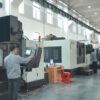The robot’s material is mainly related to the load capacity and application scenarios and has a huge relationship with the cost.
Their strength and fatigue are mainly considered for robots with medium and large loads. The structural parts are mainly cast iron, such as ABB’s IRB6700, with a load covering 150-320kg.
Small six-axis robots have lower strength and higher speed requirements, so aluminum alloys are mainly used. Different casting methods can be selected according to the different wall thickness and appearance requirements, such as gravity casting, low-pressure casting, high-pressure casting, etc. . ABB’s 1200, 1100, KUKA’s KR6, NACHI MZ07, etc. all use cast aluminum.
For intelligent robots, the material used for the parts is very important. They need to be strong, able to withstand shocks, have good load-bearing performance, and they also need to be light enough to facilitate motor operation.
Common materials for industrial robot parts can be divided into metal, non-metal, and composite materials, according to the function classification, structural materials, coating materials, control materials, etc. Now let us introduce the common materials one by one. Enjoy reading!
- Aluminum, aluminum alloys, and other light alloy materials
The common feature of this type of material is that it is light in weight, the elastic modulus E is not large, but the material density is small, so the ratio of E/ρ can still be compared with steel. The quality of some rare and precious aluminum alloys has improved. For example, the aluminum alloy with 3.2% (weight percent) lithium added, the elastic modulus increased by 14%, and the E/ρ ratio increased by 16%.
Aluminum is an excellent choice for machining smart robot components.Aluminum is easy to process, low density and lightweight, has good corrosion resistance, and can adapt to various environments.
It is worth mentioning that it is only suitable for small and medium-sized robots, and larger robots require stronger materials.
- steel
Steel is denser than aluminum and is strong and durable, ideal for large, heavy robots. It has high impact resistance and high rigidity. Alloy steel 4340 is a good choice because of its exceptional hardness and strength, with a yield strength of 72 psi.
Carbon structural steel and alloy structural steel These materials have good strength, especially alloy structural steel, whose strength is increased by 4 to 5 times, the elastic modulus E is large, and the deformation resistance is strong, which is the most widely used material.
- Polyoxymethylene (POM)
POM is an easy-to-process polymer with a smooth low coefficient of friction, ideal for gears and bushings. Its rigidity and dimensional stability are good for robots with precise movements.
- ABS plastic
ABS is strong; it has a yield strength of about 5000 psi, is less dense than aluminum and steel, and is also impact resistant, making it ideal for small robotic components.
- Fiber Reinforced Alloys
Such alloys, such as boron fiber reinforced aluminum alloys and graphite fiber reinforced magnesium alloys, have E/ρ ratios of 11.4×107 and 8.9×107, respectively. This fiber-reinforced metal material has a high E/ρ ratio but is expensive.
- ceramics
Ceramic materials have good quality but are brittle and difficult to process. Some technology companies have trial-produced ceramic robot arm samples used in small high-precision robots in Japan.
- Fiber Reinforced Composites
This kind of material has an excellent E/ρ ratio and has a very prominent advantage of large damping. Traditional metal materials cannot have such large damping, so there are more and more examples of composite materials being applied to high-speed robots.
- Viscoelastic high damping material
Increasing the damping of the robot linkage is an effective method to improve the dynamic characteristics of the robot. There are many methods to increase the damping of structural materials, and one of the most suitable methods for robots is to use viscoelastic large damping materials to perform constrained layer damping on the original components.
Special application scenarios require special structural materials. In clean environments such as medicine, stainless steel needs to be used as structural materials due to corrosion resistance and cleaning requirements—for example, ABB’s Codian and Kawasaki’s MS005N. In addition to corrosion resistance, stainless steel has many disadvantages, such as cost, heat dissipation, density, etc. It will not be applied on a large scale.
In addition, there are some niche materials, such as magnesium alloys, which are used in several small robots of ABB and FANUC. Due to the low density of magnesium alloys, the body’s weight can be reduced. However, the processing of magnesium alloys is more troublesome, and it is not a material for large-scale applications.
Follow keyanng to learn more. If you have more questions about the commonly used materials for industrial robots, please leave a message here, our professional engineers will be happy to answer you.







